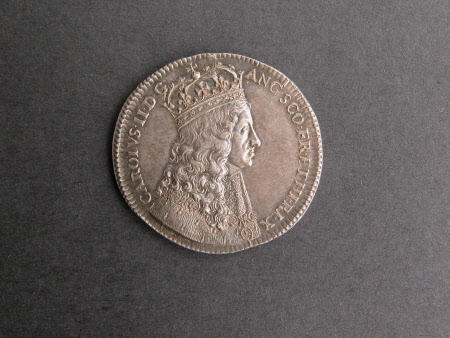Coronation of King Charles II
Thomas Simon (1618-1665)
Category
Coins and medals
Date
1661
Materials
Silver
Measurements
295 mm (Width); 282 mm (Diameter)
Place of origin
London
Order this imageCollection
Osterley Park and House, London
NT 773264
Summary
Silver, medal commemorating the coronation of King Charles II (1630-85, reigned 1660-85), by Thomas Simon (c. 1618-1665), London, United Kingdom, 1661. A silver medal by Thomas Simon commemorating the Coronation of King Charles II (1630-85, reigned 1660-85), which took place on 23 April 1661. On the obverse is a bust profile portrait of Charles II facing right, crowned, with a long wig, dressed in royal ermine robes, collar and wearing the George of the Garter. The Latin legend translates as ‘Charles II by the Grace of God King of England, Scotland, France and Ireland.’ The artist’s initials 'TS' on the truncation. On the reverse is the King enthroned and in his Coronation regalia, facing left, being crowned by Peace, who hovers above. The legend translates as ‘Sent to support a fallen age, 23 April 1661.’
Full description
Charles II had been crowned king of Scotland at Scone on 1 January 1651, but a few months later, after the disastrous battle of Worcester from which the king had a remarkable escape, he had finally managed to cross the Channel to France in October 1651, remaining in exile on the Continent for the next nine years. After his triumphant return in May 1660, the restored King Charles II was crowned at Westminster Abbey on St. George’s Day, 23 April 1661. The ceremony was carefully planned by a commission under the chairmanship of Edward Hyde, Earl of Clarendon, to create a sense of glorious rebirth and optimism for the future, and was accordingly splendid. The diarist John Evelyn caught the excitement within the city of the procession through the City on the previous day, writing that a ’magnificent train on horseback, as rich as embroidery, velvet, cloth of gold and silver, and jewels, could make them and their prancing horses, proceeded through the streets strewed with flowers, houses hung with rich tapestry, windows and balconies full of ladies; the London militia lining the ways, and the several companies, with their banners and loud music, ranked in their orders; the fountains running wine, bells ringing, with speeches made at several triumphal arches.’ Both Evelyn and Samuel Pepys were present at the ceremony in the Abbey on the following day, describing it at length, Pepys noting that silver medals were flung to the crowds, but he failed to get one. Looking back on the two days, Pepys reflected that ‘strange it is, to think that these two days have held up fair till now that all is done and the King gone out of the hall; and then it fell a-raining and thundering and lightning as I have not seen it do some years – which people did take great notice of God’s blessing of the work of these two days – which is a foolery, to take too much notice of such things.’ The medals which Samuel Pepys recorded being thrown to the crowds must have been examples of this medal, designed by Thomas Simon, which was the official Coronation medal. It has been suggested that the medal, for which Simon was paid the large sum of £110, ‘has never been surpassed for minuteness and delicacy of work’ (Medallic Illustrations, p. 473). Jeremy Warren 2019
Provenance
Given to the National Trust in 1993 by George Child Villiers, 9th Earl of Jersey (1910-1998).
Marks and inscriptions
Obverse, legend: CAROLVS. II. D.G. ANG. SCO. FR. ET. HI. REX. Obverse, truncation: TS Reverse, legend: EVERSO. MISSVS. SVCCVRRERE. SECLO. XXIII. APR. 1661
Makers and roles
Thomas Simon (1618-1665), medallist
References
Hawkins, Franks and Grueber 1885: Edward Hawkins, Augustus W. Franks and Herbert A. Grueber (eds.), Medallic Illustrations of the History of Great Britain and Ireland to the death of George II, 2 vols., London 1885, vol. I, pp. 472-73, no. 76. Alan J. Nathanson, Thomas Simon. His life and work 1618-1665, London 1975, pp. 31-34, figs. 36-37. Wollaston 1978: Henry Wollaston, The Commemorative Collectors Guide to British Official Medals for Coronations and Jubilees, Nottingham 1978, p. 6, no. 5. Mitchiner 1988-2007: Michael Mitchiner, Jetons, Medalets and Tokens, 4 vols., London 1988-2007, III (British Isles circa 1588 to 1830), 1998, p. 1684, no. 79.2 (4886). Eimer 2010: Christopher Eimer, British Commemorative Medals and their Values, London 2010, p. 55, no. 221, pl. 26.
